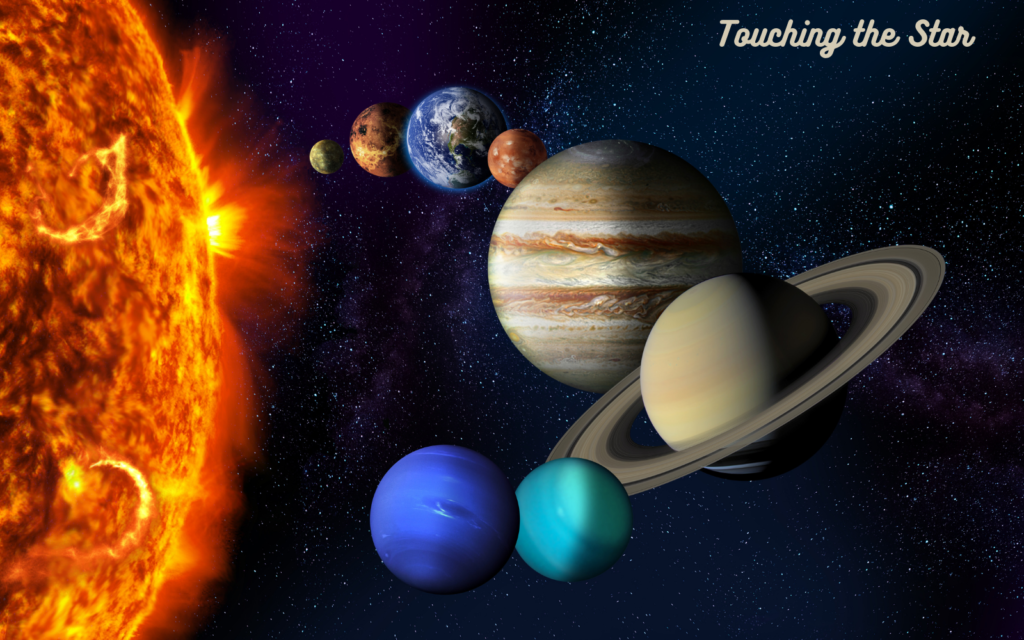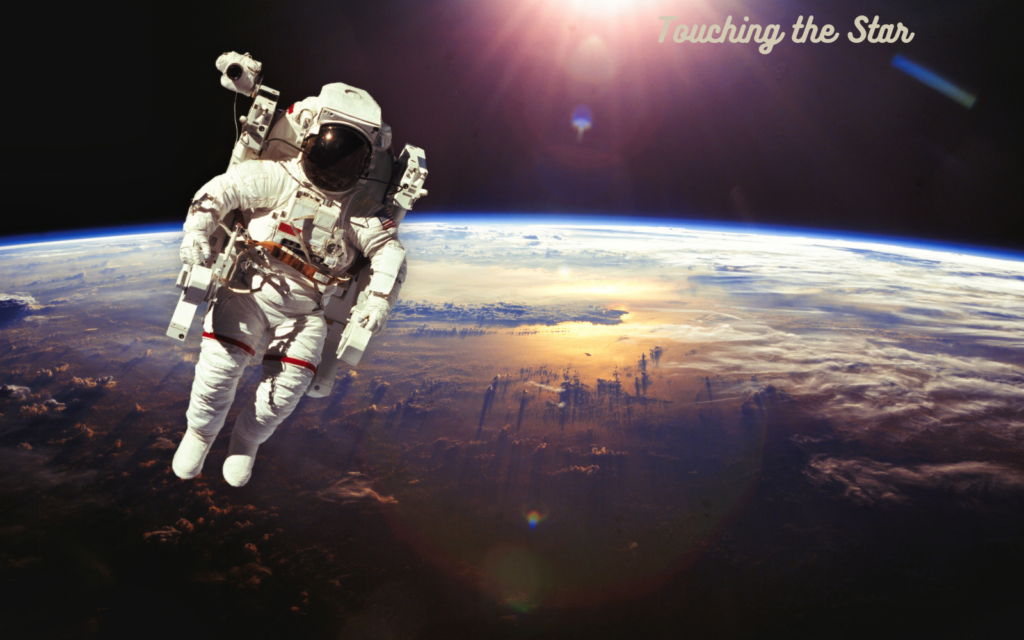Introduction: Touching the Stars: A Journey to the Outer Reaches of Space

“Touching the Stars: A Journey to the Outer Reaches of Space” sounds like a travel to the universe’s outer limits and possibly to stars. The phrase “Touch the Star” may refer to the ambitious objective of reaching these distant and strong stars. This might be done through space travel, astronomy, or fictional stories where people touch stars. Space travel, the universe’s wonders, advanced technology, or the desire to study and see more could be the topic.
Table of Contents
Exploring the vastness of outer space:
“Exploring the vastness of outer space” involves examining and analyzing galaxies, planets, stars, and other space objects beyond Earth’s atmosphere. In this sense, “Touching the Star” could entail reaching out and touching a distant, blazing star in space.
We can’t touch stars because they’re too far away and hot, but the idea might spark discussions about their beauty and power, what we know about them scientifically, and what new technology could bring us closer. People who talk about “Touching the Star” may discuss how stars evolve over time, what they are made of, their place in the universe, and how humanity wish to explore space.
Our drive to “touching the stars,” or explore the universe, stems from curiosity. Important ways people exhibit interest include:
Ancient Astronomical Observations:
Ancient people mapped the night sky, recognized patterns in stars and planets, and made up stories.
The Maya and Egyptians’ observatories and complex time systems illustrate that people have always aspired to comprehend the sky.
Scientific Revolution:
With his telescope, astronomers like Galileo helped humans see stars and planets more clearly.
Copernicus’s heliocentric paradigm transformed our view of the universe by suggesting that other worlds may exist, possibly even like ours.
Renaissance and Enlightenment Thinking:
Philosophers and scientists were eager to study and explore during the Renaissance and Age of Enlightenment.
The dream of space flight was made attainable by the development of physics and science.
Modern Rocketry and Space Exploration:
Space flight pioneer Konstantin Tsiolkovsky demonstrated the intellectual curiosity that drives us to explore beyond Earth and find out wonder of the space.
Early rocket scientists included Robert Goddard and Wernher von Braun. They did it to reach the stars.
These essential advances have kept people’s attention and inventiveness pushing the edges of what is possible, allowing them to aim for the stars.
Journeying to distant stars and galaxies:
“Journeying to distant stars and galaxies” entails investigating and possibly dwelling in distant areas from our solar system. With the term “Touching the Star,” it might indicate physically connecting with stars, massive bodies in space that emit light and heat. Hot and distant stars are scientifically impossible to touch.
However, discussing this topic can lead to discussions on other important aspects of stars, such as fusion, classification, and distance to stars in the cosmos. Future space travel technology, wormholes, warp drives, and how intriguing it is to think about visiting other star systems and galaxies may also be discussed.
Breakthroughs in Spacecraft Technology:
Advancements in Propulsion Systems:
- Spaceships can travel farther thanks to propulsion advances. New technologies like ion propulsion, solar sails, and nuclear power make space travel faster and easier.
- Ion propulsion uses ionized particles to generate thrust, which keeps it speeding up and accelerating for interstellar travel.

Propulsion Innovations:
- Electric propulsion technology and new systems like VASIMR (Variable Specific Impulse Magnetoplasma Rocket) are making deep space exploration faster and more efficient.
- New propulsion methods help decrease travel durations, carry more, and launch more ambitious missions to distant stars.
Space Habitat Development:
- New space habitat design ideas aim to create self-sustaining homes for long space journeys. Inflatable shelters, modular structures, and life support systems that grow back are needed for deep space living.
- Advanced space habitat technologies provide safe, comfortable, and useful crew quarters. This allows people to live and explore distant planets.
These new technologies improve spacecraft design, propulsion systems, life support infrastructure, and space habitats, bringing us closer to our goal of “Touching the Star.” They make it easier to explore deeper into space and set the stage for long-term human presence and exploration beyond Earth to the farthest stars in our universe.
Embracing the wonders of the universe:
“Journeying to distant stars and galaxies” entails investigating and possibly dwelling in distant areas from our solar system. With the term “Touching the Star,” it might indicate physically connecting with stars, massive bodies in space that emit light and heat.
Hot and distant stars are scientifically impossible to touch. However, discussing this topic can lead to discussions on other important aspects of stars, such as fusion, classification, and distance to stars in the cosmos. Future space travel technology, wormholes, warp drives, and how intriguing it is to think about visiting other star systems and galaxies may also be discussed.
Advancements in space technology:
“Advancements in space technology” are new and improved space study and use instruments, equipment, and systems. “Touching the Star” could suggest that technology progress will allow us to come closer to stars. Better telescopes, satellites, and sensors could allow humans to study stars from afar, even though touching a star is still impossible.
In terms of space technology progress, “Touching the Star” may include new ways to go into deep space, better telescopes for studying stars and galaxies, new designs for long-term spacecraft, and the idea of building structures or habitats near stars for scientific purposes.
Human curiosity and the quest for knowledge:
Comparing “Human Curiosity and the Quest for Knowledge” to “Touching the Star” highlights how individuals are naturally drawn to study and discover new things, even when faced with impossible tasks like touching a star. “Touching the Star” symbolizes our insatiable curiosity, which pushes science and technology.
It sparks creativity and new space exploration. Comparing “Touching the Star” to the history of astronomical discoveries, space exploration missions, and the scientific search to understand the cosmos, including stars and their role, can stir deep thinking. This exploration can lead to discussions about how we will never stop learning about the universe and the fascinating things we may find as we aim for the stars.

Imagining future possibilities in space exploration:
In “Touching the Star,” “Imagining future possibilities in space exploration” may make you think about technology improvements that could bring us closer to the stars. Even if humans can’t touch a star, the thought inspires new space technologies and exploration ideas.
People may imagine “Touching the Star” in the context of imagining what might be possible in the future of space exploration, such as using advanced spacecraft or robotics to study stars up close, new ways to travel between stars, or scientific outposts near stars. This exploration can spark innovative conversations about unknown space zones, technical obstacles, and unlimited discovery and exploration possibilities.
Practical Benefits of Space Technology on Everyday Life:
Technological Innovation:
- Space science advances satellite communications, GPS navigation, medical imaging, and environmental monitoring.
- Miniaturized electronics, superior materials, and remote sensing technologies from space missions are currently applied in numerous industries, improving life on Earth.
Earth Observation and Climate Monitoring:
- Space technology track Earth’s climate, weather, natural disasters, and environmental changes.
- Satellite monitoring of deforestation, urban growth, water quality, and farming helps individuals make better resource management and disaster response decisions.
Medical and Health Innovations:
- Space exploration has improved medical imaging, telemedicine, and virtual healthcare for Earthlings.
- Portable diagnostic gadgets and telemedicine services, originally developed for space missions, have helped rural and underprivileged populations access adequate medical treatment.
Looking at how aiming for the stars has affected art, literature, philosophy, and daily life shows how it has shaped our culture, technology, and societal advancement. The objective of “Touching the Star” inspires creativity and leads to significant improvements in our lives on Earth.
Reverence for the beauty and mystery of the cosmos:
Looking deeper into “Reverence for the beauty and mystery of the cosmos” in “Touching the Star,” you’re amazed and awed by how huge and complicated the universe is, especially when you think about stars as celestial creatures with beauty and mystery. The keyword “Touching the Star” symbolizes our awe of the universe. It depicts our fascination with stars as light, heat, and symbols of hope and inspiration.
Thinking about “Touching the Star” in the context of “Reverence for the beauty and mystery of the cosmos” may make you reflect about starry skies, how stars have significant connotations in human civilization, and how they transform our understanding of existence. Numerous universe riddles remain unsolved. This exploration can help us realize how interconnected all celestial bodies are and how insignificant we are.
Inspiring wonder and awe through astronomical discoveries:
In “Touching the Star,” “Inspiring wonder and awe through astronomical discoveries” emphasizes how crucial it is for fresh discoveries to amaze us. Reaching out toward the unknown with “Touching the Star” can signify trying to discover the universe’s secrets through science.
Discussing “Touching the Star” and “Inspiring Wonder and Awe through Astronomical Discoveries” may involve discussing how astronomical discoveries like exoplanets, stellar phenomena, and the universe’s secrets have transformed people’s lives. These presentations can inspire individuals to explore the world and its beauty and complexity, as well as their intelligence and desire to understand it. These links show how cosmic discoveries excite and astonish us, motivating us to keep searching for knowledge.
Technological Advancements : Innovations Driven by the Quest:
- The objective of “Touching the Star” has advanced technology in propulsion, life support, space colonies, and more.
- These gadgets enable us learn about space and improve our daily lives by improving communications, health, and environmental monitoring.
Human Spaceflight :Challenges and Achievements:
- Progress has been made in safely sending and returning people to space. These include making spaceships more durable, boosting life support, and finding safe means to re-enter the atmosphere.
- Plans for manned journeys to the Moon, Mars, and beyond illustrate that humans are still exploring the solar system. This allows interstellar travel.
Conclusion:
The book “Touching the Stars: A Journey to the Outer Reaches of Space” discusses the plan to explore the universe using stars as light and energy. “Touch the Star” symbolizes our yearning to connect with space’s wondrous objects.
This online topic takes us on a journey of exploration via the universe’s beauty and secrets and the challenges of interacting with stars in the actual world. While feeling a star is still a distant fantasy due to their size and weight, it symbolizes our never-ending quest for knowledge and the universe’s awe-inspiring splendor.
“Touching the Stars” makes us think about how hard it is to journey into space, how new technology are helping us understand the universe, and how astronomical results shape our worldview. As we explore space, it reminds us to follow our passions, preserve our sense of wonder, and reach for the heavens.
“Touching the Stars: A Journey to the Outer Reaches of Space” reveals how curious, innovative, and driven individuals are to learn more. This excursion expanded our cultural and moral knowledge as well as science and technology. To address a basic human need, we increase space exploration. We want to reach, study, and touch the stars.
People also ask:
Unfortunately, people may never be able to reach the edge of the universe because it is so big and keeps growing faster than the speed of light.
Due to the speed of light and the age of the universe, the edge of the visible universe is the farthest we can see. It is about 93 billion light-years across.
Pingback: The Wonders of Space Exploration: From Moon to Mars Missions
Pingback: Space Exploration: Past, Present, and Future